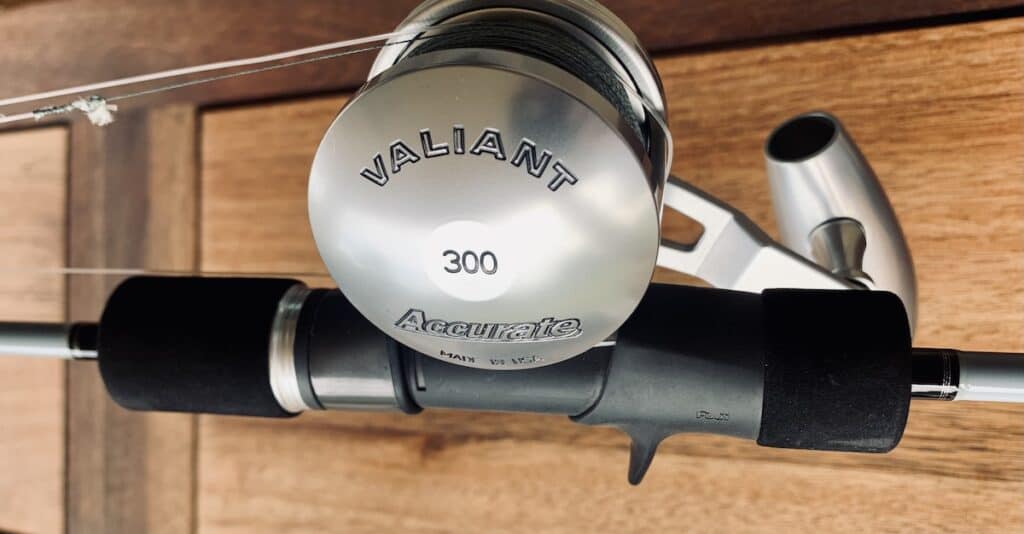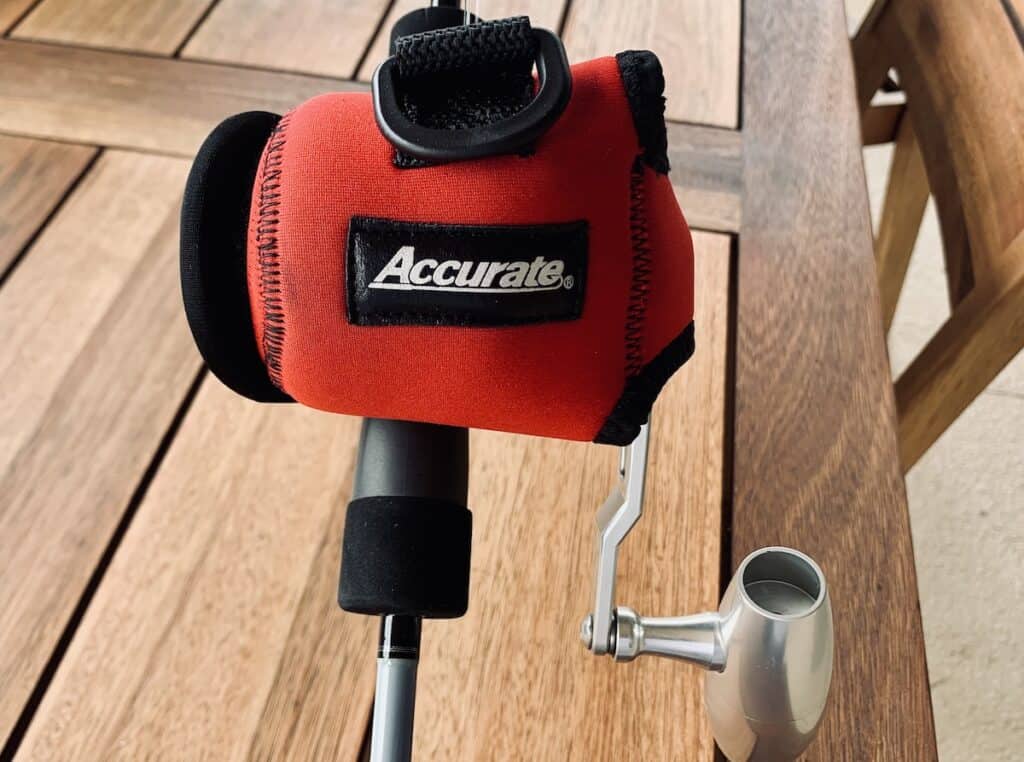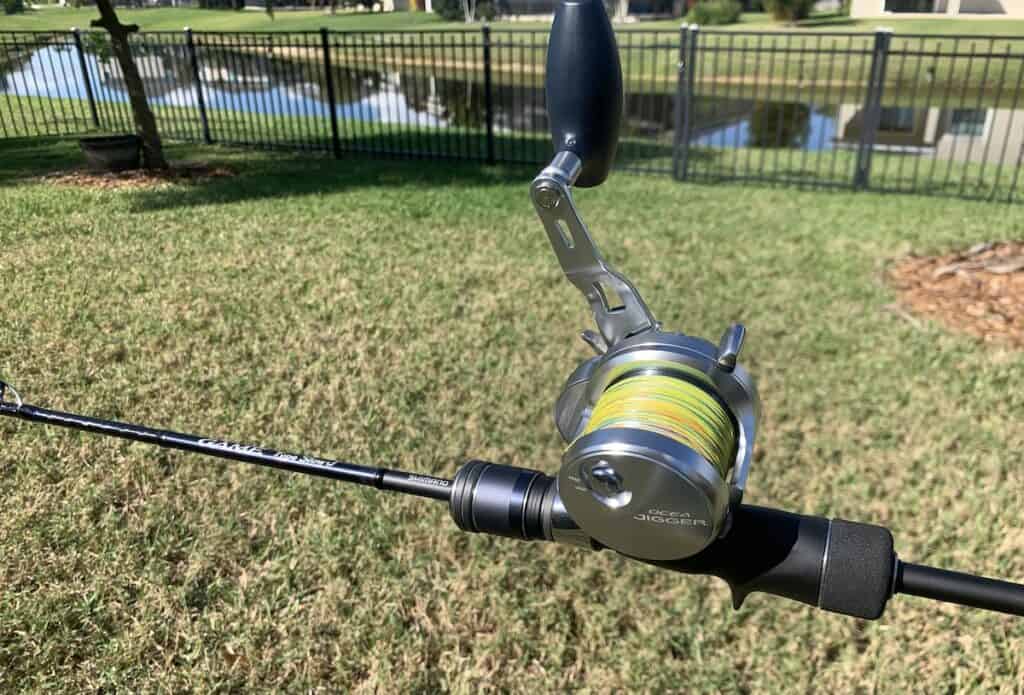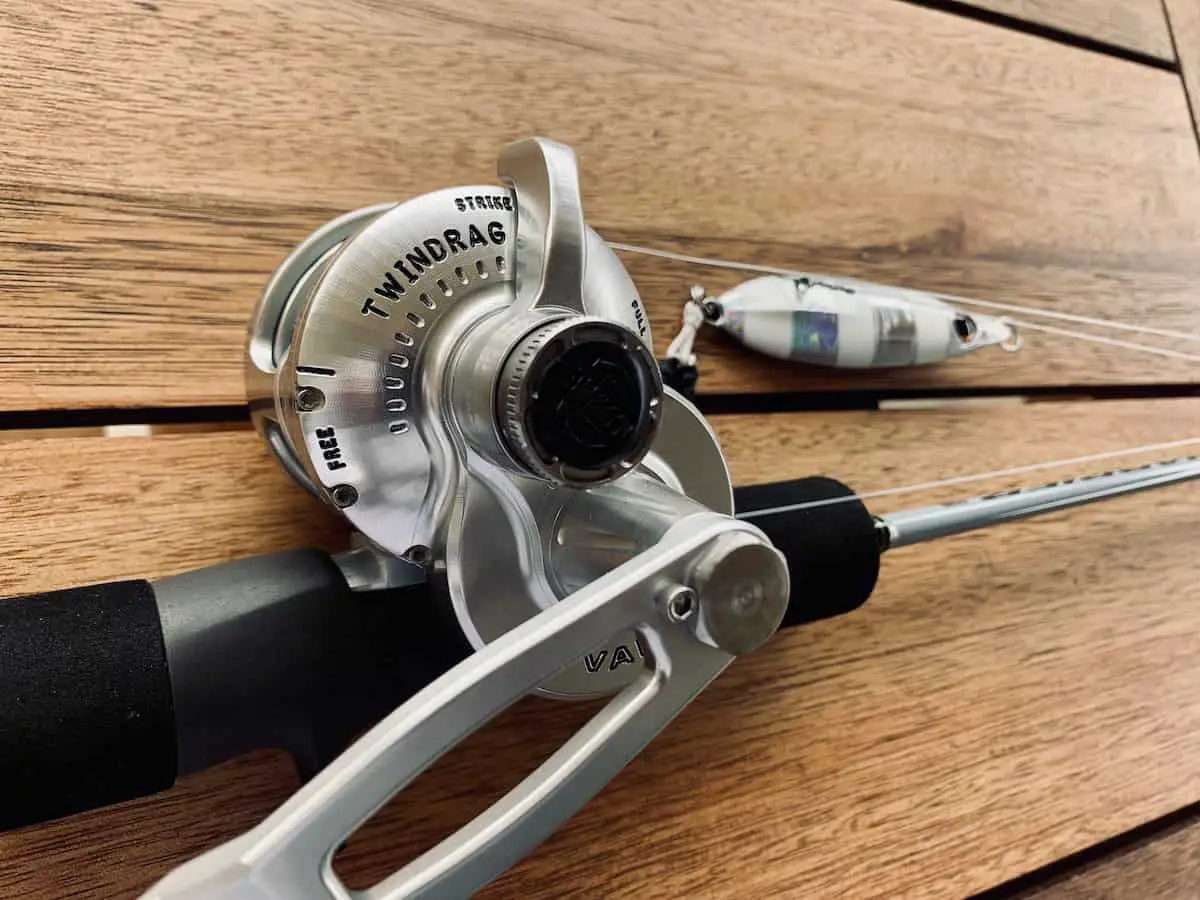Slow pitch jigging is a relatively new technique in the United States and the variety of reels on the market has steadily grown as the technique has become more popular. Some of the most popular ones are the Shimano Ocea Jigger, Accurate Boss Valiant SPJ, and Daiwa Saltiga. When it comes to reel specs and features, some are better suited for slow pitch jigging. This article will walk you through the specs and how they may or may not matter for a slow pitch jigging technique.
Conventional vs Spinning Reels for Slow Jigging
The first decision to understand when you start looking at reels is whether you want a conventional or a spinning reel. A spinning reel has the spool’s axis parallel to the rod and the reel is mounted on the underside of the rod. A conventional reel has the spool’s axis perpendicular to the rod and the reel is mounted on the top side of the rod. Although these are clear differences, what’s more important when choosing the reel for your technique is understanding how you’ll be working the rod and reel to see which one would be more comfortable.
When doing a slow pitch jigging method, the angler is holding the rod the entire time. The reel is put in freespool and a jig slowly falls to the ocean floor. Once the jig hits bottom, the angler brings the jig back up a few feet and then releases it again until a strike occurs. The angler will want to be able to control the speed the jig falls. Freespool is easily slowed down with thumb pressure on a conventional reel, but is more difficult on a spinning reel. Some anglers will grip the line between two fingers to slow down the freespool on a spinning reel, but this can cause injury to the angler if using braided fishing line. Shimano’s Ocea Jigger is a unique jigging reel with a cast control knob which can be used to control the rate of freespool. This can be a real advantage because you can better ensure the same drop speed on multiple drops.
When slow jigging with a conventional setup, you’ll be holding the rod and reel in one hand and retrieving with the other. It’s important for the reel to be a comfortable size so that your hand can palm it while also letting your fingers wrap around the rod. A narrow reel is also key for slow pitch jigging because it minimizes the need for manually levelwinding. The reel is narrow enough that it naturally lays the line evenly across the width of the spool, and you can esily push or pull the line with your thumb to tweak its position.
What Size Reel Should I Get?
The reel size is determined by the line capacity. The question of how much line capacity do you need is a common and very critical question, especially with slow pitch reels. Keep in mind that the jig is meant to hit bottom, so you must have enough line capacity to reach bottom with some bow in the line from the current.
The line capacity is also greatly affected by the type of line you choose to use. Braid is a much better choice for main line for a slow pitch jigging technique for several reasons. Braided fishing line has a much smaller diameter than monofilament fishing line. You can pack many more yards of braid on a small and narrow reel, than you can monofilament. When slow jigging, fish will usually strike softly because the bait imitates a dying baitfish that doesn’t require a hard strike. For the angler to feel such a soft bite, the fishing line must be highly sensitive, like braid. The lack of stretch in braided line also helps set the hook in a soft strike.
My article Is Braid or Mono Best for Jigging? goes into much more detail about the tradeoffs with braid and mono. And to when looking to add a leader line, read my article Jigging Leaders: Why You Need One and How to Choose It.
Although it’s clear now that we want to spool the reel with braided line, we still haven’t talked about how to estimate how much you really need. To maximize comfort when doing this technique, you’ll want to have enough capacity for your fishery, but not so much that you upsize the reel without truly needing it.
For me, I’ll mostly be doing this technique off the East coast of Florida, between Fort Pierce Inlet and Port Canaveral, within 20 miles of shore. Looking at my TopSpot map, I can see the depths stay at or below 100 Fathoms, or 600 feet, or 200 yards.
I’ll also periodically use this setup when I take trips down to Islamorada. The waters can get much deeper on the Atlantic side of the keys, but realistically, I know I’ll use this technique around some of the more shallow reefs. There’s no way I’m slow jigging in 1800 ft of water. Can you imagine reel all that line back in?!
Considering my usual fisheries, I feel that a line capacity a little over 300 yards will be good. About 300 yards should let me hit bottom, with some margin for a fight, deeper water, and inflated reel specs.
Line capacity specs also depend on the strength of the line you plan to spool the reel with. Although braided line is much smaller in diameter than monofilament, there is still variation with the braided line diameter for different pound test line. For slow pitch jigging, the line strength is usually pretty light. Most often, you’ll use 30 lb test line. Contrary to what you may think, an even lighter line is commonly used for deeper water and larger fish. This is because of the light line’s ability to cut through the water, helping the angler maintain contact with the jig throughout the water column.
Weight can also be a factor in deciding the reel size. Since this is a technique where the rod and reel are held constantly through the motion, a light reel can be much more comfortable. A lightweight reel can improve your endurance when doing this technique for hours.
The table below shows a few different sizes of the most popular slow pitch jigging reels on the market in America. There are additional models for left hand retrieve or custom paint jobs or lower gear ratios for some of these reels. The Accurate Boss Valiant also has left hand retrieve models and special paint job models which are omitted to keep the table concise. The Shimano Ocea Jigger has low gear ratio models omitted to keep the table focused on slow pitch jigging models.
| Reel | Model | Braid Capacity | Weight | Price |
| Shimano Ocea Jigger | OCEAJG1500HG | 40/300 | 14.3oz | $520 |
| Shimano Ocea Jigger | OCEAJG2000NRHG | 40/400 | 21oz | $550 |
| Shimano Ocea Jigger | OCEAJG4000HG | 50/740 | 27.9oz | $620 |
| Accurate Boss Valiant SPJ | BV-300-SPJ | 30/325 | 9.9oz | $480 |
| Accurate Boss Valiant SPJ | BV2-300-SPJ | 30/325 | 14.3oz | $640 |
| Accurate Boss Valiant SPJ | BV-500N-SPJ | 50/300 | 15oz | $560 |
| Accurate Boss Valiant SPJ | BV2-500N-SPJ | 50/300 | 15.3oz | $670 |
| Accurate Boss Valiant SPJ | BV-600N-SPJ | 65/400 | 20.6oz | $600 |
| Accurate Boss Valiant SPJ | BV2-600N-SPJ | 65/400 | 21.6oz | $700 |
| Daiwa Saltiga Lever Drag Jigging | SAGLD35JH | 30/440 | 20.8oz | $580 |
When I look at these models, I can immediately narrow it down to 4 reel models.
- Ocea Jigger 1500 (OCEAJG1500HG)
- Accurate Boss Valiant 300 (BV-300-SPJ or BV2-300-SPJ)
- Daiwa Saltiga (SAGLD35JH)
These 4 reel models meet my requirement of a minimum of 300 yards of 30 lb test line capacity. Note that although the line capacity of the Ocea Jigger 1500 is listed as 300 yards with 40 lb test braid, we know that 30 lb test braid is smaller in diameter, and the capacity with 30 lb test braid will exceed 300 yards. The single speed Boss Valiant is incredibly lightweight, at only 9.9 oz.

Max Drag and Star vs Lever Drag
Conventional reels are available with either a lever drag or a star drag system. A lever drag system applies drag by putting pressure on the drag washers which directly push against the side of the spool. Twisting the drag preset knob up increases the allowable drag and moving it down decreases the allowable drag. The lever itself allows for a drag setting at strike and drag setting at full. The strike setting is usually the default setting and the angler can increase up to strike if needed to wear down a fish.
Star drag is adjusted with a star shaped clicking mechanism next to the handle. As the knob is turned clockwise, the drag setting increases. As the knob is turned counter clockwise, the drag setting decreases. Drag is applied by putting pressure on the drag washers which push against the drive gear. The drive gear is in contact with the pinion gear which moves the spool. Although the drag washers in a star drag setup are smaller, similar max drag is available because of the drag washer stack, a series of washers and discs stacked together to increase friction on the drive gear.
Star drag and lever drag can have similar max drags. The smaller washers in a star drag system can warp easier because they have a more difficult time releasing heat when the drag is screaming. Aside from this, both star drag and lever drag work well for slow pitch jigging. The drag style is mostly a personal preference for this technique.
The amount of drag needed for slow pitch jigging is relatively low because of the light line strength. The drag setting should be about 30% of the breaking strength of the line, which amounts to about 10 lbs when using 30 lb test line. I will recommend keeping a margin, though, because drag washers, and therefore drag performance, tends to degrade with extensive use. As part of reel maintenance, drag washers can be replaced when you notice a degradation in performance.
| Reel | Drag Type | Max Drag |
| OCEAJG1500HG | Star | 15 |
| OCEAJG2000NRHG | Star | 22 |
| OCEAJG4000HG | Star | 40 |
| BV-300-SPJ | Lever | 23 |
| BV2-300-SPJ | Lever | 26 |
| BV-500N-SPJ | Lever | 30 |
| BV2-500N-SPJ | Lever | 30 |
| BV-600N-SPJ | Lever | 32 |
| BV2-600N-SPJ | Lever | 32 |
| SAGLD35JH | Lever | 40 |
I’ll be spooling my reel with 30 lb test line, and setting the drag at 10 lbs, which is roughly 30% of the breaking strength of the line. Every reel in this table meets my requirement of 10 lbs of drag minimum.
Gear Ratio and Retrieve Rate for Slow Jigging
Novice anglers will sometimes assume that a slow retrieve rate, and lower gear ratio, is better for slow pitch jigging. However, this is not the case. When slow pitch jigging, the lure descends to the bottom in freespool and then the rod is twitched back up and falls again. The technique is used to target bottom fish such as grouper and snapper. These fish will strike and then immediately dart back into cover and attempt to break off the line.
Strong power comes in handy when the grouper dart back into the reef and attempt to break you off. The strong power comes from a low gear ratio, which typically accompanies a slower retrieve rate.
A fast retrieve rate usually accompanies a high gear ratio. This fast speed will help you quickly reel in fish and jigs from the bottom. A two speed reel can help with both of these situations. You’ll be able to use the low gear ratio for the hookset at the bottom, and then switch to high gear for the remainder of the retrieve.
| Reel | Gear Ratio | Retrieve Rate | Price |
| OCEAJG1500HG | 6.4:1 | 39IPT | $520 |
| OCEAJG2000NRHG | 6.2:1 | 46IPT | $550 |
| OCEAJG4000HG | 5.1:1 | 46IPT | $620 |
| BV-300-SPJ | 6:1 | 38IPT | $480 |
| BV2-300-SPJ | 6:1/3:1 | 38/19IPT | $640 |
| BV-500N-SPJ | 6:1 | 45IPT | $560 |
| BV2-500N-SPJ | 6:1/3:1 | 45/23IPT | $670 |
| BV-600N-SPJ | 6:1 | 53IPT | $600 |
| BV2-600N-SPJ | 5:1/2.2:1 | 44/19IPT | $700 |
| SAGLD35JH | 6.3:1 | 47IPT | $580 |
Of the 4 reel models I’m considering, only one is a two speed reel. The Boss Valiant BV2-300-SPJ. Although two speeds could be nice to have, I feel the general size and weight is more important for me, so I’ll eliminate the BV2-300-SPJ from my consideration.
Slow Pitch Jigging Reel Handle
When looking for a slow pitch jigging reel, one of the tell-tale signs is the handle design. You can go online to a tackle store and filter on conventional reels with a high gear ratio of at least 6:1, you’ll see some reels with a circular knob and some with a banana handle. The reels specifically designed for slow pitch jigging will have a banana handle.
The banana handle helps the angler fight fatigue by giving the hand more to hold onto. Fishermen will do a slow pitch jigging technique for hours and reel in several good sized fish. You’ll want a handle that makes you feel like you have a good grip to get those fish in the boat. Often times, reel manufacturers will make a slow pitch jigging version of an existing reel, such as Daiwa’s Saltiga reel. The slow pitch Daiwa Saltiga Lever Drag (JH model) has a banana handle while the other Daiwa Saltiga lever drag reels do not.

Choosing My Slow Pitch Jigging Reel
Throughout the article, you’ve seen me narrow my list of reel models down to three. I was hoping the answer would be obvious when comparing these 3 specific models, but they all have similar specs and would all work for my fishery. If I had to choose based on the single most important factor for me, it would be the Accurate Boss Valiant 300 SPJ because it has the lowest weight.

How about I throw a curve ball at you and tell you I actually already own the Accurate Boss Valiant 300 SPJ and am looking for a second reel to try. This time, I’ll go with the Shimano Ocea Jigger 1500 HG because it's the second lightest reel and has a cast control knob that I’m interested in trying out for jigging. This lever will help me repeat the same presentation over and over without depending so much on me being consistent with my thumb pressure.
| Reel | Shimano Ocea Jigger | Accurate Boss Valiant SPJ | Daiwa Saltiga Lever Drag Jigging |
| Model | OCEAJG1500HG | BV-300-SPJ | SAGLD35JH |
| Braid Capacity | 40/300 | 30/325 | 30/440 |
| Weight | 14.3oz | 9.9oz | 20.8oz |
| Drag Type | Star | Lever | Lever |
| Max Drag | 15 | 23 | 40 |
| Gear Ratio | 6.4:1 | 6:1 | 6.3:1 |
| Retrieve Rate | 39 IPT | 38 IPT | 47 IPT |
| Price | $520 | $480 | $580 |
I hope this article helps you choose a slow pitch jigging reel. I’ll be sure to film some slow jigging fun with these reels and put it up on my YouTube channel. Tight lines, y’all!
Recent Posts
Fat Cow Jig Strips: The Ultimate Bucktail Jig Upgrade for Surf Fishing
As discussed in my previous article, "Surf Fishing with Bucktail Jigs: Ultimate Guide for Beach Anglers," bucktail jigs are a staple in any surf angler's tackle box, offering a versatile way to catch...
In my previous article, "Surf Fishing with Bucktail Jigs: Ultimate Guide for Beach Anglers," I introduced you to the bucktail jig and discussed how versatile of a lure it is for catching a wide range...

